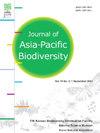Genetic diversity of freshwater shrimp Palaemon paucidens around Lake Biwa, Japan with the invasion of foreign genotypes
IF 0.7
Q4 BIODIVERSITY CONSERVATION
引用次数: 0
Abstract
Palaemon paucidens is a freshwater shrimp widely distributed mainly in East Asia. Palaemonid shrimps are collected in Japan for fishing bait. They are also imported from South Korea and China. Currently, there are concerns about the negative impacts that the escape and establishment of these commercially transported individuals may have on local populations, such as on their genetic disturbance. In this study, molecular genetic analysis based on 16S rDNA of 229 individuals collected along the coast of Lake Biwa was conducted to clarify genetic population structure of the shrimp in the lake, which is a major harvesting area in Japan. A total of seven haplotypes (Hap1-7) were identified, and the most frequent haplotype (Hap1) was consistent with the haplogroup (A-I) determined in a previous study. In addition, another haplogroup (A-Biwa) consisting of four haplotypes (Hap2,5-7) was subsequently confirmed, and three (Hap5-7) of these haplotypes were identified for the first time in this study. The other two haplotypes (Hap3, 4) were presumed to be of foreign origin, probably from South Korea. There is strong concern that these foreign haplotypes will not only spread throughout Lake Biwa but will also spread to other parts of Japan via shrimp transport, causing synergistic genetic disturbance.
外来基因型入侵下琵琶湖淡水对虾的遗传多样性
paucidens Palaemon paucidens是一种淡水对虾,主要分布在东亚。在日本,人们收集巨虾作为鱼饵。它们也从韩国和中国进口。目前,人们担心这些商业运输的个体的逃脱和建立可能对当地种群产生负面影响,例如对其遗传干扰。本研究对日本主要捕捞区琵琶湖(Lake Biwa)沿岸229只虾进行了16S rDNA分子遗传分析,阐明了琵琶湖对虾的遗传群体结构。共鉴定出7个单倍型(Hap1-7),其中最常见的单倍型(Hap1)与前人研究确定的单倍群(A- i)一致。此外,另一个单倍群(A-Biwa)由4个单倍型(Hap2,5-7)组成,其中3个单倍型(Hap5-7)为本研究首次发现。另外两个单倍型(Hap3, 4)被认为是来自国外,可能来自韩国。人们非常担心这些外来单倍型不仅会在琵琶湖传播,还会通过虾类运输传播到日本其他地区,造成协同遗传干扰。
本文章由计算机程序翻译,如有差异,请以英文原文为准。
求助全文
约1分钟内获得全文
求助全文
来源期刊

Journal of Asia-Pacific Biodiversity
Agricultural and Biological Sciences-Insect Science
CiteScore
1.70
自引率
12.50%
发文量
94
审稿时长
27 days
期刊介绍:
The Journal of Asia-Pacific Biodiversity (previous title was Journal of Korean Nature) is an official journal of National Science Museum of Korea (NSMK) and Korea National Arboretum (KNA). The scope of journal is wide and multidisciplinary that publishes original research papers, review articles, as well as conceptual, technical and methodological papers on all aspects of biological diversity-its description, analysis and conservation, and its application by humankind. This wide and multidisciplinary journal aims to provide both scientists and practitioners in conservation theory, policy and management with comprehensive and applicable information. However, papers should not be submitted that deal with microorganisms, except in invited paper. Articles that are focused on the social and economical aspects of biodiversity will be normally not accepted.
 求助内容:
求助内容: 应助结果提醒方式:
应助结果提醒方式:


